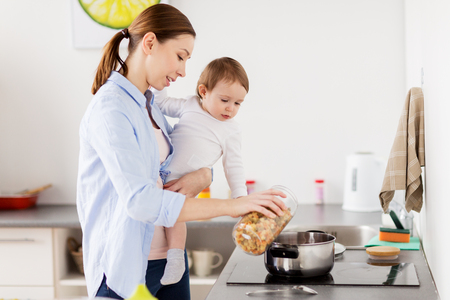Introduction to Weaning in the UK
As a new parent in the UK, starting your baby’s weaning journey can feel both exciting and a little daunting. Weaning simply means introducing your little one to solid foods alongside their usual breast milk or formula feeds. According to NHS guidelines, most babies are ready to begin weaning at around six months old, although every child is unique and you’ll learn to spot the signs that your baby is ready. In the UK, we’re lucky to have clear advice from health professionals encouraging a gradual approach, where you begin with simple tastes and textures and progress at your baby’s own pace.
Homemade weaning recipes are becoming increasingly popular amongst British families. Not only do they allow you to introduce your baby to a range of local flavours and fresh ingredients, but making food at home means you know exactly what’s going into every spoonful. It’s also a great way to save money and reduce waste – which is always handy when you’re juggling nappies and bottles! In this article, I’ll share my own experience as a new mum navigating weaning in the UK, along with simple and nutritious homemade recipe ideas that suit our British lifestyle and culture.
2. Essential Ingredients for Homemade Baby Food
When I started weaning my little one here in the UK, I quickly realised how important it is to use locally available, fresh ingredients that are both nutritious and gentle on tiny tummies. Here’s a handy list of staple UK-friendly ingredients to keep stocked in your kitchen, alongside tips for making the most of seasonal produce and prepping everything safely.
Staple UK-Friendly Ingredients
| Ingredient | Why It’s Great for Babies | Common Ways to Use |
|---|---|---|
| British Carrots | Sweet flavour, full of vitamin A | Puréed alone or mixed with potatoes |
| Maris Piper Potatoes | Mild taste, easy to digest carbs | Mashed with peas or swede |
| Broccoli (UK-grown) | Packed with vitamins C & K | Steamed and blended with cheese sauce |
| Porridge Oats | Gentle fibre and slow-release energy | Cooked with breast milk/formula, or mixed with fruit purée |
| Bramley Apples | Naturally sweet and high in vitamin C | Stewed and served solo or added to porridge |
| Garden Peas (Frozen or Fresh) | Good source of plant protein & iron | Puréed for a smooth texture or mashed for older babies |
| Chicken Breast (British Farmed) | Lean protein for growth and development | Puréed with root veg or shredded for finger foods later on |
| Lentils (Red or Green) | Budget-friendly iron and protein boost | Cooked into soft stews with veg or blended into soups |
Seasonal Produce Suggestions (UK)
- Spring: Asparagus, spring greens, new potatoes, rhubarb (for older babies, cooked well)
- Summer: Courgettes, strawberries (well-mashed), green beans, broad beans, blueberries (crushed)
- Autumn: Butternut squash, parsnips, apples, pears, leeks, blackberries (strained for seeds)
- Winter: Swede, carrots, Brussels sprouts (well-cooked and blended), celeriac, kale (finely chopped and cooked)
Tips for Buying & Prepping Fresh Foods Safely
- Buy British where possible: Look out for “Red Tractor” labels at supermarkets and farmers’ markets.
- Avoid added salt and sugar: Babies’ kidneys can’t handle extra salt; keep things as natural as possible.
- Wash thoroughly: Even organic fruit and veg need a good rinse under cold water to remove any dirt or pesticides.
- Peel and chop appropriately: Remove tough skins and seeds; cut veg into even pieces so they cook evenly.
- Bake, steam or boil until soft: Always test the texture before blending or mashing – it should be easy to squash between your fingers.
A Personal Note from My Kitchen!
I found that prepping batches of carrot and parsnip mash during autumn made my weaning journey less stressful. Batch cooking and freezing in small portions meant I always had a healthy meal ready – just be sure to cool food quickly and label those containers with dates!
![]()
Simple Purees to Begin With
When you’re just starting your weaning journey, simple purees are often the best way to introduce new tastes and textures to your baby. As a first-time mum living in the UK, I found that gentle, familiar flavours made all the difference for my little one. Many British parents start with classic vegetables and fruits—these are not only easy to prepare at home but also packed with nutrients that support your baby’s healthy growth.
Carrot and Parsnip Puree
This combination is a real winner in our house! Both carrots and parsnips are naturally sweet, which makes them appealing to most babies. Simply peel and chop equal amounts of carrots and parsnips, steam until soft, then blend with a splash of cooled boiled water or your baby’s usual milk for a perfectly smooth texture. The mild taste is gentle on tiny tummies and introduces British root veggies early on.
Apple and Pear Mash
For something fruity, apple and pear mash is an absolute favourite. Peel, core, and chop one apple and one pear, then steam or simmer until tender. Mash together using a fork or blitz in a blender for extra smoothness. This puree is naturally sweet without added sugar, making it ideal for young babies just beginning to explore solid foods.
Tips for Smooth Textures
When preparing these purees, aim for a very smooth consistency at first—think runny yoghurt or double cream. If your puree seems too thick, just add a little more cooled boiled water or breast/formula milk. Remember, every baby is different; some might prefer slightly thicker purees as they get used to eating from a spoon.
Why Homemade?
Making your own purees means you know exactly what’s going into your baby’s meals—no hidden salt, sugar, or additives. Plus, you can tailor recipes using seasonal UK produce, supporting local farmers and introducing your baby to ingredients they’ll see as they grow up. Starting with these easy recipes helped me feel more confident as a new mum navigating the world of weaning!
4. First Finger Foods and Textured Meals
Once your baby is comfortable with smooth purees, it’s time to introduce a wider range of textures. This stage is all about encouraging little hands to explore, helping develop fine motor skills and confidence with self-feeding. In my own experience as a new mum in the UK, I found that finger foods not only made mealtimes more fun but also gave my baby a real sense of independence. Here are some simple, nutritious recipe ideas using ingredients you’ll easily find in any British kitchen or local supermarket.
Easy Finger Food Recipes
| Recipe | Main Ingredients | How to Prepare |
|---|---|---|
| Soft Steamed Broccoli Florets | Broccoli, water | Steam broccoli until very soft (about 8-10 mins). Let cool and serve as chunky florets for grasping. |
| Mashed Potato Cakes | Potato, mature Cheddar, egg, flour (optional) | Mash boiled potatoes, mix with grated cheese and a beaten egg. Shape into small patties; pan-fry in a little oil until golden and cooked through. |
| Cheese & Vegetable Muffins | Self-raising flour, eggs, milk, Cheddar cheese, mixed veg (e.g. carrot, courgette, peas) | Mix all ingredients in a bowl. Spoon into mini muffin tins and bake at 180°C for 15–20 mins until firm and lightly golden. |
Why These Recipes Work for UK Babies
These recipes are tried-and-tested classics among British families because they use pantry staples like potatoes, Cheddar cheese, and seasonal vegetables from the local greengrocer or supermarket. They’re naturally soft enough for babies learning to chew but still offer interesting textures. Plus, they’re easy to batch-cook and freeze—something I’ve come to rely on during busy weeks!
Top Tips for Success
- Always check that finger foods are soft enough to squish between your fingers before offering them to your baby.
- Avoid adding salt—babies’ kidneys can’t handle much sodium at this stage.
- If you’re sharing family meals, set aside a portion for your little one before seasoning for adults.
This phase of weaning is both exciting and messy (trust me—it’s worth it!). With these easy recipes tailored to UK tastes and produce, you’ll help your baby build healthy eating habits right from the start.
5. Allergy Awareness and Meal Variation
As a new parent in the UK, one of my main concerns during the weaning journey was food allergies. It’s important to be mindful of common allergens such as cow’s milk, eggs, peanuts, tree nuts, fish, shellfish, soy, and wheat – all frequently found in UK households. When introducing these foods to your baby for the first time, I recommend offering each potential allergen separately and waiting at least three days before trying another new ingredient. This helps you spot any reactions early, such as skin rashes or tummy troubles. If you have a family history of allergies, it’s always wise to speak with your health visitor or GP before starting.
To keep mealtimes exciting and nutritious, I loved planning meals that introduced a variety of tastes and textures. Try rotating different vegetables, grains like oats or quinoa, and proteins such as lentils or chicken each week. This not only broadens your baby’s palate but also ensures they get a wide range of nutrients. Don’t be afraid to adapt classic British family favourites for your little one—think shepherd’s pie made with sweet potato mash or a mild fish pie using salmon and peas.
If your baby has dietary needs, such as dairy-free or gluten-free requirements, simple recipe swaps can make homemade weaning meals safe and inclusive. Use oat milk instead of cow’s milk, or swap out wheat-based pasta for lentil pasta. The key is to plan ahead so you always have suitable options on hand. With a bit of creativity and allergy awareness, you can confidently create tasty homemade meals that suit every member of the family.
6. Tips for Fuss-Free Weaning
Weaning can be a rollercoaster, especially when your little one suddenly turns their nose up at what was yesterday’s favourite meal. From my experience, the secret lies in patience and a sprinkle of British practicality! Here are some tried-and-tested tips to help you navigate fussy eating, make batch cooking a breeze, and create enjoyable mealtimes using UK traditions.
Dealing with Picky Eaters
If your baby is turning away from peas or spitting out mashed carrots, don’t panic—it’s completely normal. I found that offering a variety of flavours (think root veg mash one day, apple and pear purée the next) helps develop their palate. Try not to pressure your baby; instead, let them explore food with their hands. In our house, we always placed a few steamed carrot sticks alongside a spoonful of porridge—sometimes it ended up on the floor, but eventually curiosity won!
Batch Cooking for Busy Families
The trick to stress-free homemade weaning is batch cooking. Every Sunday afternoon, I’d whip up big pots of lentil and vegetable stew or chicken and sweet potato mash—classic British comfort foods—and freeze them in small portions. Ice cube trays or small containers are lifesavers here. This way, you always have a healthy homemade meal ready to go, even on the busiest days.
Building Positive Mealtime Routines
British families often gather round the table for tea or supper—it’s a tradition worth embracing even for babies. We made mealtimes a relaxed family affair: no distractions, lots of chatter, and everyone eating together (even if your baby is just playing with a crust of toast). Letting your child see you enjoying healthy food encourages them to try new things too.
Above all, remember that every baby is different—what works for one might not work for another. Stay calm, keep experimenting with simple recipes like fish pie or veggie bakes, and celebrate each tiny milestone along the way. With these UK-inspired tips, you’ll soon find weaning becomes less stressful and more enjoyable for both you and your little one!
7. Frequently Asked Questions about Homemade Weaning
Can I freeze homemade weaning recipes?
Absolutely! Freezing is a lifesaver for busy UK parents. Most homemade purees, veggie mashes, and even small portions of cottage pie or fish pie freeze well. Use ice cube trays or small reusable pots. Remember to label with the date and ingredients. Defrost in the fridge overnight or use a microwave if you’re in a hurry.
How do I safely re-heat baby food?
Always reheat until piping hot throughout and then allow it to cool down before offering to your baby. If using a microwave, stir thoroughly to avoid hotspots. Never reheat food more than once and discard any leftovers that your baby hasn’t finished, as their saliva can introduce bacteria.
What are the best ways to store homemade weaning meals?
Store fresh meals in the fridge (use within 48 hours) or freeze in small portions for up to 2-3 months. Glass or BPA-free plastic containers work well. Make sure everything is sealed properly to keep food fresh and safe.
Can I take homemade baby food on-the-go?
Yes! Pack cooled food into leak-proof containers or pouches and keep them chilled in an insulated bag with an ice pack, especially during warmer UK months. For longer outings, ready-to-eat finger foods like steamed veggies, cheese cubes, or oatcakes are brilliant British options.
When can I introduce classic British dishes?
You can start introducing simple versions of British favourites around 6-8 months, making sure they’re low in salt and sugar. Think mashed potatoes, shepherd’s pie (with no added gravy granules), or soft-cooked flaked fish like cod with peas. Always mash or finely chop and check for bones or choking hazards.
Any tips for making weaning easier for new parents?
Batch cooking is your friend—set aside an afternoon to prepare several recipes at once. Mix familiar flavours with new ones; for example, combine parsnip with apple or add a dash of mild curry powder to lentils for a British-inspired twist. Most importantly, enjoy the messy moments—your little one is learning every day!


